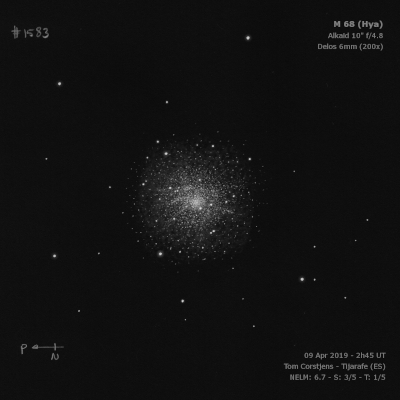
Charles Messier discovered M68 = NGC 4590 = h3404 on 9 Apr 1780. WH described "a beautiful cluster of stars, extremely rich, and so compressed that most of the stars are blended together; it is near 3' broad and about 4' long, but chiefly round, and there are very few scattered stars about." In his 1814 publication he noted "this oval cluster is also approaching to the globular form, and the central compression is carried to a high degree." JH made the single observation "GC; irr R; gbM; diam in RA = 12...15 sec. All clearly resolved into stars 12 m; very loose and ragged at the borders."
200/250mm - 8" (3/24/84): few stars resolved across disk.
300/350mm - 13.1" (3/24/84): about 20 stars resolved around edges of core and in halo. The core is mottled but unresolved.
400/500mm - 17.5" (2/28/87): 30-50 stars resolved including many fairly bright stars over unresolved background haze.
600/800mm - 24" (5/22/17): at 375x; very bright, well resolved globular with quite a number of surprisingly bright stars [brightest stars Vtip = 12.6] spread over the central region and around the edges, giving a fairly loose appearance [class X]. The unresolved central background glow is large and bright. Perhaps 60-75 stars are resolved in the central region, but excluding the outer portion of the halo, which also seems to contain a number of brighter stars out to at least 8'.
Notes by Steve Gottlieb